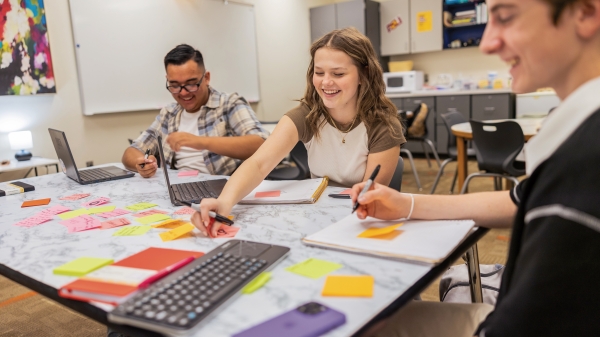Finding strength in tradition

A young woman dances at the annual Veterans Day Weekend Pow Wow at the ASU West Valley campus on Nov. 10, 2018. ASU photo
Growing up in urban environments presents unique struggles for American Indian families. In these crowded and hectic spaces, cultural traditions can feel distant, and long-held community ties may be harder to sustain. For a people deeply rooted in connections to one another, this can feel isolating and potentially contribute to disproportionately higher rates of mental health challenges.
But there’s another side to the story — one of resilience.
According to a study from Arizona State University, cultural roots may play a powerful role in supporting American Indian youth. Led by Associate Professor Monica Tsethlikai and featured in a special section on Indigenous Child Development — the introduction for which Tsethlikai served as lead editor and lead author — the findings suggest that when caregivers maintain deep connections to their cultural heritage, it helps shield their children from the harmful effects of stress.
Drawing from the well of cultural connection
The study gathered data from 161 urban American Indian children and their caregivers, such as parents or relatives. Through questionnaires, caregivers shared about their own cultural ties — including pride in their heritage and participation in spiritual practices — while also reporting on their children’s exposure to stressful life events.
On average, the children had experienced six major life stressors, ranging from the loss of a parent to a close relative’s incarceration. However, when their caregivers stayed closely connected to their culture, the mental health impacts of these events were notably reduced. Children of connected caregivers were less likely to show symptoms of PTSD and anger despite the hardships they endured.
“It’s striking how resilient these kids can be when they have a strong cultural foundation to lean on,” Tsethlikai said. “They’re going through incredibly tough situations, but the support and connection they feel through their heritage makes a difference.”
Beyond psychological effects, the researchers also measured the children’s cortisol levels — an indicator of chronic stress — through hair samples. Elevated cortisol is associated with mental health issues like anxiety and depression.
Interestingly, while cultural connection was linked to reduced symptoms of PTSD and anger, it was not associated with a change in cortisol levels. This suggests that while cultural ties offer emotional resilience, other types of intervention may be needed to address the biological effects of chronic stress.
“With 22% of American Indian children diagnosed with PTSD — three times the rate of the general population — interventions that help children manage and reduce stress are still critical,” said Tsethlikai, part of the Sanford School of Social and Family Dynamics at ASU.
Imparting strength to future generations
The study calls for more research into how cultural practices can be woven into mental health interventions for American Indian children, especially those growing up in cities. The findings suggest that fostering cultural connections early in a child’s life is crucial, as younger children are more open to participating in cultural activities.
“By staying connected to their heritage, these families are passing down traditions and strength,” Tsethlikai said. “It’s about preserving the past and creating a healthier future.”
This focus on resilience and capability also stands in contrast to the typical tone of American Indian scholarship. Historically, much of the research on this group has centered around deficits — framed by challenges like poverty, discrimination and trauma. While these are critical issues, an overemphasis on problems can paint an incomplete and limiting view of the community.
“We’re starting to see the value of focusing on strengths rather than just problems,” Tsethlikai added. “This study is one of the first to blend Western and Indigenous perspectives to explore both the vulnerabilities and the assets of urban (American Indian) caregivers and children.”
By focusing on resilience, the study offers a new understanding of how American Indian families can use their cultural connections to both preserve traditions and nurture emotional strength for future generations.
This study was conducted with support from the William T. Grant Foundation. Co-authors of the study include Kevin Korous and Juyoung Kim.
More Arts, humanities and education
Illuminating legacy at ASU
In 2020, the ASU Art Museum unveiled a groundbreaking installation, "Point Cloud (ASU)," by renowned artist Leo Villareal. The art piece was given a permanent home on the Tempe campus in 2024 thanks…

Name change for ASU's Mary Lou Fulton Teachers College reflects college's mission
Arizona State University’s Mary Lou Fulton Teachers College has a new name: the Mary Lou Fulton College for Teaching and Learning Innovation.The name change, which will be completed in time for the…

Exhibit to feature artwork inspired by oral histories from Arizona's oldest botanical garden
Though it is Arizona's largest botanical garden and has been an established touchstone of the community for more than 100 years, many students in Arizona State University Professor Ellen…